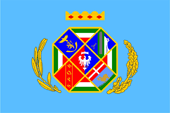Latium |
|
|
|
| Übersicht – Contents: | |
Latium |
|
|
|
| Übersicht – Contents: | |
Flagge – Flag: |
|
 |
Flagge des Latium – flag of Latium, Seitenverhältnis – ratio = 2:3, Quelle/Source, nach/by: Wikipedia (D) |
Bedeutung/Ursprung der Flagge – Meaning/Origin of the Flag: |
|
| Die Flagge des Latium ist einfarbig hellblau und zeigt in der Mitte das Logo der Region. Dies ist ein achteckiges Emblem, das in neun Felder aufgeteilt ist. Vier zeigen die italienischen Nationalfarben, die anderen fünf Felder die Wappenbilder der fünf Provinzen der Region Latium: Viterbo, Rieti, Roma, Frosinone, Latina. Es gibt Varianten der Flagge mit Lorber- und Olivenzweigen links und rechts des Emblems, sowie oberhalb eine goldene Krone. Es gibt auch Versionen der Flagge, die zusätzlich noch die goldene Inschrift "REGIONE LAZIO" zeigen. Weiterhin sind auch weiße Flaggen mit dem Latium-Emblem bekannt. | The flag
of Latium is single-coloured pale blue and shows in the middle the logo of
the region. This is an octagonal emblem, which is divided into nine fields.
Four of them show the Italian national colors, the other five fields show
the of the coats of arms of the five provinces of Latium: Viterbo, Rieti,
Rome, Frosinone, Latina. There are variations of the flag with laurel and olive branches on the left and on the right side of the emblem, and a golden crown above. There are also versions of the flag, which additionally show the golden inscription "REGIONE LAZIO". Furthermore are known, white flags with the emblem of Latium. |
| Quelle/Source: nach/by: Wikipedia (D) | |
Landkarte der
Regionen Italiens – Map of the Regions of Italy: |
|
| Landkarte/Map: Volker Preuß |
Zahlen und Fakten – Numbers and Facts: |
|
|
|
|
|
|
|
|
|
|
|
|
|
Geschichte: |
|
6. Jhd. v.Chr.
· im Latium siedeln die Latiner, deren Gebiete ab ca. 300 v.Chr. vollständig
zur Stadt Rom gehören 410 n.Chr. · Einfall der Westgoten 476 · Absetzung des letzten römischen Kaisers Romulus Augustulus, Ende des (West)Römischen Reiches, das Latium gehört bis 493 zum Reich des Odoaker 536 · Eroberung durch Byzanz (Ostrom) 568/569 · Langobarden erobern das Latium und gliedern es ihrem Reich ein 756 · das heutige Latium geht zusammen mit Umbrien als Lehen vom König der Franken an den Papst ("Pippinsche Schenkung"), Entstehung des Kirchenstaats (Patrimonium Petri) 774 · Eroberung Italiens durch die Franken, der Kirchenstaat bleibt bestehen 843 · bei der Teilung des Frankenreiches kommt der Kichenstaat zum Königreich Italien 961 · Otto I. bringt den Kichenstaat an das Deutsche Königreich 1209 · ein großer Teil des Herzogtums Spoleto (heute Teil von Umbrien) wird vom Kirchenstaat (Patrimonium Petri) erworben 1796 · Italienfeldzug Napoléons 1798 · französische Truppen Napoléons marschieren in Rom ein, der Papst geht nach Valence in Frankreich, der Kirchenstaat (Patrimonium Petri) wird "Römische Republik" 1799 · Abzug der französischen Truppen, Einmarsch von Truppen des Königreichs Neapel, Ende der Römischen Republik 1801 · Konkordat mit Frankreich zur Wiederherstellung des Kirchenstaats 1808 · die Marken und die Romagna werden durch Napoléon vom Kirchenstaat abgetrennt und dem Königreich Italien unter König Napoléon I. angeschlossen 1815 · Wiener Kongress, Wiederherstellung des Kirchenstaats 1860 · Umbrien, Marken and die Romagna werden von Sardinien-Piemont annektiert 17.03.1861 · Krönung von Viktor Emanuel II. von Sardinien-Piemont zum König des Königreichs Italien 1947 · Gründung der Region Latium als Verwaltungseinheit |
History: |
|
6th cent. B.C.
· in the Latium settle the Latins, whose territories belong compelety to
Rome since ca. 290 B.C. 410 A.D. · invasion of the Western Goth 476 · dismissal of the last Roman emperor Romulus Augustulus, end of the (West)Roman Empire, Latium belongs until 493 to the Empire of the Odoaker 536 · conquest by Byzantium (East Rome) 568/569 · Langobards conquest the Latium and incorporate it into their empire 756 · the Latium goes together with the today's Umbria as fiefdom from the King of the Franks to the Pope ("Donation of Pippin"), establishment of the Papal States (Patrimonium Petri) 774 · conquest of Italy by the Franks, the Papal States persist 843 · at the division of the Frankish Empire the Papal States come to the Kingdom of Italy 961 · Otto I. brings the Papal States to the German Kingdom 1209 · a large part of the Duchy of Spoleto (today a part of Umbria) gets purchased from the Papal States (Patrimonium Petri) 1796 · Italy Campaign of Napoléon 1798 · French troops of Napoléon march into Rome, the Pope goes to Valence in France, the Papal States (Patrimonium Petri) become the "Roman Republic", in 1799 Papal States again, but is in 1809 annexed by France 1799 · withdrawal of the French troops, invasion of troops from the Kingdom of Naples, the "Roman Republic" ends 1801 · concordat with France, restore of the Papal States 1808 · Marches and the Romagna become separated by Napoléon from the Papal States and annexed to the Kingdom of Italy under King Napoléon I. 1815 · Congress of Vienna, restore of the Papal States 1860 · Umbria, Marches and the Romagna become annexed by Sardinia-Piedmont 17th of March 1861 · coronation of Victor Emmanuel II. of Sardinia-Piedmont to the King of the Kingdom of Italy 1947 · establishment of the Latium region as administrative unit |
| Quelle/Source: Meyers Konversationslexikon, Atlas zur Geschichte, Wikipedia (D) |
Ursprung des Landesnamens – Origin of the Country's Name: |
|
| Der Name der "Latium" wurde schon in der Antike verwendet. Er beschreibt das ursprüngliche Siedlungsgebiet der Latiner (Lateiner), jedoch war damit in der Antike lediglich der äußerste Süden des heutigen Latium gemeint (Latina). | The name
"Latium" was already used in ancient times. It describes the initial settlement area the Latins, but only the farthest south of the today's Latium was meant with this term in the antiquity (Latina). |
| Quelle/Source: Wikipedia (D) | |